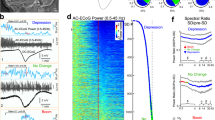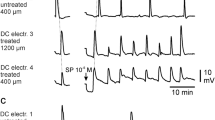Abstract
Spreading depolarization (SD) is a wave of almost complete depolarization of the neuronal and glial cells. Nowadays there is sufficient evidence demonstrating its pathophysiological effect in migraine with aura, transient global amnesia, stroke, subarachnoid hemorrhage, intracerebral hemorrhage, and traumatic brain injury. In these cases, occurrence of SD has been associated with functional neuronal damage, neuronal necrosis, neurological degeneration, and poor clinical outcome. Animal models show that SD can be modulated by drugs that interfere with its initiation and propagation. There are many pharmacological targets that may help to suppress SD occurrence, such as Na+, K+, Cl−, and Ca2+channels; Na+/K+-ATPase; gap junctions; and ligand-based receptors, for example, adrenergic, serotonin, sigma-1, calcitonin gene-related peptide, GABAA, and glutamate receptors. In this regard, N-methyl-d-aspartate (NMDA) receptor blockers, in particular, ketamine, have shown promising results. Therefore, theoretically pharmacologic modulation of SD could help diminish its pathological effects.
Access this chapter
Tax calculation will be finalised at checkout
Purchases are for personal use only
Similar content being viewed by others
References
Afridi SK, Giffin NJ, Kaube H, Goadsby PJ (2013) A randomized controlled trial of intranasal ketamine in migraine with prolonged aura. Neurology 80(7):642–647
Ayata C (2009) Spreading depression: from serendipity to targeted therapy in migraine prophylaxis. Cephalalgia 29(10):1095–1114
Ayata C, Jin H, Kudo C, Dalkara T, Moskowitz MA (2006) Suppression of cortical spreading depression in migraine prophylaxis. Ann Neurol 59(4):652–661
Bough KJ, Schwartzkroin PA, Rho JM (2003) Calorie restriction and ketogenic diet diminish neuronal excitability in rat dentate gyrus in vivo. Epilepsia 44(6):752–760
Brunson KL, Khanna A, Cromwell HC, Cohen RW (2001) Effect of the noncompetitive NMDA antagonists MK-801 and ketamine on the spastic Han-Wistar mutant: a rat model of excitotoxicity. Dev Neurosci 23(1):31–40
Costa C, Tozzi A, Rainero I, Cupini LM, Calabresi P, Ayata C, Sarchielli P (2013) Cortical spreading depression as a target for anti-migraine agents. J Headache Pain 14(1):62
Dichgans M, Freilinger T, Eckstein G et al (2005) Mutation in the neuronal voltage-gated sodium channel SCN1A in familial hemiplegic migraine. Lancet 366(9483):371–377
Dohmen C, Sakowitz OW, Fabricius M et al (2008) Spreading depolarizations occur in human ischemic stroke with high incidence. Ann Neurol 63(6):720–728
Dreier JP (2011) The role of spreading depression, spreading depolarization and spreading ischemia in neurological disease. Nat Med 17(4):439–447
Dreier JP, Drenckhahn C, Woitzik J et al (2013) Spreading ischemia after aneurysmal subarachnoid hemorrhage. Acta Neurochir Suppl 115:125–129
Dreier JP, Ebert N, Priller J et al (2000) Products of hemolysis in the subarachnoid space inducing spreading ischemia in the cortex and focal necrosis in rats: a model for delayed ischemic neurological deficits after subarachnoid hemorrhage? J Neurosurg 93(4):658–666
Dreier JP, Körner K, Ebert N et al (1998) Nitric oxide scavenging by hemoglobin or nitric oxide synthase inhibition by N-nitro-L-arginine induces cortical spreading ischemia when K+ is increased in the subarachnoid space. J Cereb Blood Flow Metab 18(9):978–990
Dreier JP, Major S, Manning A et al (2009) Cortical spreading ischaemia is a novel process involved in ischaemic damage in patients with aneurysmal subarachnoid haemorrhage. Brain 132(Pt 7):1866–1881
Dreier JP, Windmüller O, Petzold G, Lindauer U, Einhäupl KM, Dirnagl U (2002) Ischemia triggered by red blood cell products in the subarachnoid space is inhibited by nimodipine administration or moderate volume expansion/hemodilution in rats. Neurosurgery 51(6):1457–1465; discussion 1465–1467
Dreier JP, Woitzik J, Fabricius M et al (2006) Delayed ischaemic neurological deficits after subarachnoid haemorrhage are associated with clusters of spreading depolarizations. Brain 129(Pt 12):3224–3237
Eikermann-Haerter K, Can A, Ayata C (2012) Pharmacological targeting of spreading depression in migraine. Expert Rev Neurother 12(3):297–306
Enyedi P, Braun G, Czirják G (2012) TRESK: the lone ranger of two-pore domain potassium channels. Mol Cell Endocrinol 353(1–2):75–81
Fujimoto M, Yanase H (1991) The effect of K(+)-conductance-blocking substances on the occurrence of retinal spreading depression. Exp Eye Res 53(3):333–336
De Fusco M, Marconi R, Silvestri L, Atorino L, Rampoldi L, Morgante L, Ballabio A, Aridon P, Casari G (2003) Haploinsufficiency of ATP1A2 encoding the Na+/K+ pump alpha2 subunit associated with familial hemiplegic migraine type 2. Nat Genet 33(2):192–196
Gorji A (2001) Spreading depression: a review of the clinical relevance. Brain Res Brain Res Rev 38(1–2):33–60
Haglund MM, Schwartzkroin PA (1990) Role of Na-K pump potassium regulation and IPSPs in seizures and spreading depression in immature rabbit hippocampal slices. J Neurophysiol 63(2):225–239
Hartings JA, Bullock MR, Okonkwo DO et al (2011) Spreading depolarisations and outcome after traumatic brain injury: a prospective observational study. Lancet Neurol 10(12):1058–1064
Hartings JA, Watanabe T, Bullock MR et al (2011) Spreading depolarizations have prolonged direct current shifts and are associated with poor outcome in brain trauma. Brain 134(Pt 5):1529–1540
Hernándéz-Cáceres J, Macias-González R, Brozek G, Bures J (1987) Systemic ketamine blocks cortical spreading depression but does not delay the onset of terminal anoxic depolarization in rats. Brain Res 437(2):360–364
Hertle DN, Dreier JP, Woitzik J et al (2012) Effect of analgesics and sedatives on the occurrence of spreading depolarizations accompanying acute brain injury. Brain 135(Pt 8):2390–2398
Kaube H, Herzog J, Käufer T, Dichgans M, Diener HC (2000) Aura in some patients with familial hemiplegic migraine can be stopped by intranasal ketamine. Neurology 55(1):139–141
Kudo C, Toyama M, Boku A, Hanamoto H, Morimoto Y, Sugimura M, Niwa H (2013) Anesthetic effects on susceptibility to cortical spreading depression. Neuropharmacology 67:32–36
Kunkler PE, Kraig RP (2004) P/Q Ca2+ channel blockade stops spreading depression and related pyramidal neuronal Ca2+ rise in hippocampal organ culture. Hippocampus 14(3):356–367
Lauritzen M, Dreier JP, Fabricius M, Hartings JA, Graf R, Strong AJ (2011) Clinical relevance of cortical spreading depression in neurological disorders: migraine, malignant stroke, subarachnoid and intracranial hemorrhage, and traumatic brain injury. J Cereb Blood Flow Metab 31(1):17–35
Leng LZ, Fink ME, Iadecola C (2011) Spreading depolarization: a possible new culprit in the delayed cerebral ischemia of subarachnoid hemorrhage. Arch Neurol 68(1):31–36
Leo AAP (1944) Spreading depression of activity in the cerebral cortex. J Neurophysiol 7(6):359–390
Loss CM, Córdova SD, de Oliveira DL (2012) Ketamine reduces neuronal degeneration and anxiety levels when administered during early life-induced status epilepticus in rats. Brain Res 1474:110–117
Van den Maagdenberg AMJM, Pizzorusso T, Kaja S et al (2010) High cortical spreading depression susceptibility and migraine-associated symptoms in Ca(v)2.1 S218L mice. Ann Neurol 67(1):85–98
Margineanu DG, Klitgaard H (2006) The connexin 36 blockers quinine, quinidine and mefloquine inhibit cortical spreading depression in a rat neocortical slice model in vitro. Brain Res Bull 71(1–3):23–28
Martins-Ferreira H, Ribeiro LJ (1995) Biphasic effects of gap junctional uncoupling agents on the propagation of retinal spreading depression. Braz J Med Biol Res 28(9):991–994
Mion G, Villevieille T (2013) Ketamine pharmacology: an update (pharmacodynamics and molecular aspects, recent findings). CNS Neurosci Ther 19(6):370–380
Peters O, Schipke CG, Hashimoto Y, Kettenmann H (2003) Different mechanisms promote astrocyte Ca2+ waves and spreading depression in the mouse neocortex. J Neurosci 23(30):9888–9896
Russell MB, Ducros A (2011) Sporadic and familial hemiplegic migraine: pathophysiological mechanisms, clinical characteristics, diagnosis, and management. Lancet Neurol 10(5):457–470
Sakowitz OW, Kiening KL, Krajewski KL, Sarrafzadeh AS, Fabricius M, Strong AJ, Unterberg AW, Dreier JP (2009) Preliminary evidence that ketamine inhibits spreading depolarizations in acute human brain injury. Stroke 40(8):e519–e522
Sánchez-Porras R, Zheng Z, Santos E, Schöll M, Unterberg AW, Sakowitz OW (2013) The role of spreading depolarization in subarachnoid hemorrhage. Eur J Neurol 20(8):1121–1127
Shapira Y, Artru AA, Lam AM (1992) Ketamine decreases cerebral infarct volume and improves neurological outcome following experimental head trauma in rats. J Neurosurg Anesthesiol 4(4):231–240
Shapira Y, Lam AM, Eng CC, Laohaprasit V, Michel M (1994) Therapeutic time window and dose response of the beneficial effects of ketamine in experimental head injury. Stroke 25(8):1637–1643
Smischney NJ, Beach ML, Loftus RW, Dodds TM, Koff MD (2012) Ketamine/propofol admixture (ketofol) is associated with improved hemodynamics as an induction agent: a randomized, controlled trial. J Trauma Acute Care Surg 73(1):94–101
Smith JM, Bradley DP, James MF, Huang CL-H (2006) Physiological studies of cortical spreading depression. Biol Rev Camb Philos Soc 81(4):457–481
Somjen GG (2001) Mechanisms of spreading depression and hypoxic spreading depression-like depolarization. Physiol Rev 81(3):1065–1096
Tobiasz C, Nicholson C (1982) Tetrodotoxin resistant propagation and extracellular sodium changes during spreading depression in rat cerebellum. Brain Res 241(2):329–333
Tottene A, Urbani A, Pietrobon D (2011) Role of different voltage-gated Ca2+ channels in cortical spreading depression: specific requirement of P/Q-type Ca2+ channels. Channels (Austin) 5(2):110–114
Wang M, Chazot PL, Ali S, Duckett SF, Obrenovitch TP (2012) Effects of NMDA receptor antagonists with different subtype selectivities on retinal spreading depression. Br J Pharmacol 165(1):235–244
Windmüller O, Lindauer U, Foddis M, Einhäupl KM, Dirnagl U, Heinemann U, Dreier JP (2005) Ion changes in spreading ischaemia induce rat middle cerebral artery constriction in the absence of NO. Brain 128(Pt 9):2042–2051
Woitzik J, Dreier JP, Hecht N et al (2012) Delayed cerebral ischemia and spreading depolarization in absence of angiographic vasospasm after subarachnoid hemorrhage. J Cereb Blood Flow Metab 32(2):203–212
Wu Y-J, Boissard CG, Greco C et al (2003) (S)-N-[1-(3-morpholin-4-ylphenyl)ethyl]- 3-phenylacrylamide: an orally bioavailable KCNQ2 opener with significant activity in a cortical spreading depression model of migraine. J Med Chem 46(15):3197–3200
Zheng Z, Sanchez-Porras R, Santos E, Unterberg AW, Sakowitz OW (2012) Delayed cerebral ischemia after subarachnoid hemorrhage: from vascular spasm to cortical spreading depolarizations. Curr Neurovasc Res 9(4):310–319
Conflict of Interest Statement
We declare that we have no conflict of interest.
Author information
Authors and Affiliations
Corresponding author
Editor information
Editors and Affiliations
Rights and permissions
Copyright information
© 2015 Springer International Publishing Switzerland
About this chapter
Cite this chapter
Sánchez-Porras, R., Zheng, Z., Sakowitz, O.W. (2015). Pharmacological Modulation of Spreading Depolarizations. In: Fandino, J., Marbacher, S., Fathi, AR., Muroi, C., Keller, E. (eds) Neurovascular Events After Subarachnoid Hemorrhage. Acta Neurochirurgica Supplement, vol 120. Springer, Cham. https://doi.org/10.1007/978-3-319-04981-6_26
Download citation
DOI: https://doi.org/10.1007/978-3-319-04981-6_26
Published:
Publisher Name: Springer, Cham
Print ISBN: 978-3-319-04980-9
Online ISBN: 978-3-319-04981-6
eBook Packages: MedicineMedicine (R0)




